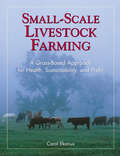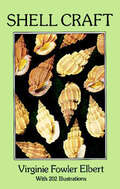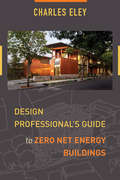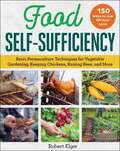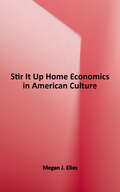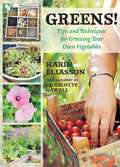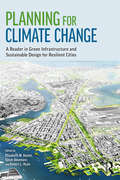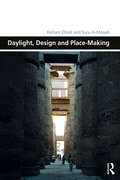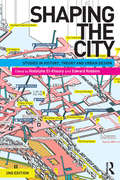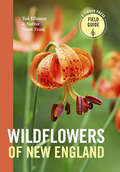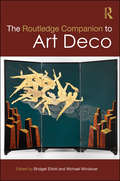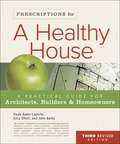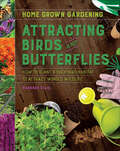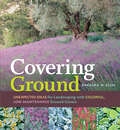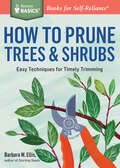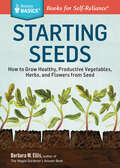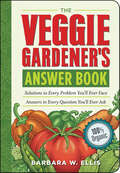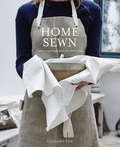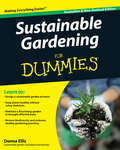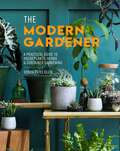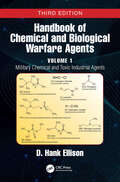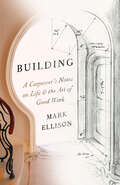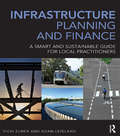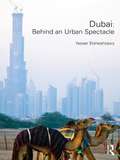- Table View
- List View
Small-Scale Livestock Farming: A Grass-Based Approach for Health, Sustainability, and Profit
by Carol EkariusFull of practical everyday advice, this guide explains how a natural, organic approach to livestock farming produces healthy animals, reduces costs, and increases your operation&’s self-sufficiency. Livestock expert Carol Ekarius helps you create a viable farm plan, choose suitable livestock, care for your animals&’ health, and confidently manage housing, fencing, and feeding. Case studies of successful farmers provide inspiration as you learn everything you need to know to run a prosperous livestock farm and make the lifestyle of your dreams a reality. This publication conforms to the EPUB Accessibility specification at WCAG 2.0 Level AA.
Shell Craft
by Virginie Fowler ElbertSince ancient times, seashells have provided both materials and design inspiration for a variety of arts and crafts. Shell-inspired motifs have turned up in pottery and floor mosaics, as architectural ornaments, and on furniture. The magnificent mollusks have also been used as money and decorative objects to adorn the body. This comprehensive guide by Virginie Fowler Elbert -- noted author, crafter, and authority on shell lore -- offers a wealth of craft ideas for using these lovely treasures from the sea.Following a fascinating introduction to the use of shells throughout history, the simply written text provides step-by-step instructions for cleaning, preparing, and displaying shells; suggests methods for decorating boxes and mirror frames; and shows how to create fanciful soap dishes, night lights, and jewelry items -- from pendants and necklaces to bracelets, cuff links, and earrings.You'll also find easy-to-follow directions for preserving shells in resin to make paperweights, napkin holders, cachepots, and other household accessories, as well as instructions for casting shell forms from molds (an ideal way to develop multiple patterns if only a few shells are available). There's even a chapter on how to do shell printing with linoleum blocks and crayon prints to create distinctive designs for placemats, wall hangings, wrapping paper, and stationery. Reference works and an updated list of supply sources round out this profusely illustrated guide to a fun-filled and rewarding pastime.
Design Professional's Guide to Zero Net Energy Buildings
by Charles EleyIn the United States, direct energy use in buildings accounts for 39% of carbon dioxide emissions per year--more than any other sector. Buildings contribute to a changing climate and warming of the earth in ways that will significantly affect future generations. Zero net energy (ZNE) buildings are a practical and cost-effective way to reduce our energy needs, employ clean solar and wind technologies, protect the environment, and improve our lives. Interest in ZNE buildings, which produce as much energy as they use over the course of a year, has been growing rapidly.In the Design Professional's Guide to Zero Net Energy Buildings, Charles Eley draws from over 40 years of his own experience, and interviews with other industry experts, to lay out the principles for achieving ZNE buildings and the issues surrounding their development. Eley emphasizes the importance of building energy use in achieving a sustainable future; describes how building energy use can be minimized through smart design and energy efficiency technologies; and presents practical information on how to incorporate renewable energy technologies to meet the lowered energy needs. The book identifies the building types and climates where meeting the goal will be a challenge and offers solutions for these special cases. It shows the reader, through examples and explanations, that these solutions are viable and cost-effective.ZNE buildings are practical and cost-effective ways to address climate change without compromising our quality of life. ZNE buildings are an energizing concept and one that is broadly accepted yet, there is little information on what is required to actually meet these goals. This book shows that the goal is feasible and can be practically achieved in most buildings, that our construction industry is up to the challenge, and that we already have the necessary technologies and knowledge.
Food Self-Sufficiency: Basic Permaculture Techniques for Vegetable Gardening, Keeping Chickens, Raising Bees, and More
by Robert ElgerA practical back-to-basics guide to achieving food security and financial independence. What if you could really raise or grow all the food your family needs? In this fully illustrated book, you&’ll learn to create an autonomous, diversified, and sustainable garden and to cultivate and maintain it following the main principles of permaculture. If you want to move towards greater food autonomy and you have sufficient space, you can also grow grains, keep chickens, and have a few beehives. Design and grow a prolific organic vegetable gardenLearn how to save seeds from one year to the nextDiscover techniques for collecting waterRead about beekeeping tools and how to use themLearn about chicken breeds and how to keep your birds healthy and happy Gaining food autonomy means depending less on grocery stores and food supply chains. But it is also offers the pleasure of eating healthy and delicious products straight from your land, while respecting the environment.
Stir It Up: Home Economics in American Culture
by Megan J. EliasFor Americans who came of age in the mid-twentieth century, home economics conjures memories of burnt toast and sewing disasters. But as historian Megan Elias shows in Stir It Up, home economics began as an idealistic reform movement in higher education in the early 1900s. Leaders of this movement sought to discover and disseminate the best methods for performing domestic work while creating new professional options for women that were based on elements of home life. Home and family were treated as subjects for scientific analysis; students wore lab coats while baking bread and performed rigorous tests on the palatability of their work. The Federal Bureau of Home Economics supplied a grateful audience with informational bulletins as Americans seemed to accept the idea that home could be a site for social change. <p><p>A major shift occurred in the 1950s, when new ideas about women's roles seemed to divert home economics into more traditional channels, and "home ec" became identified with the era's conformist culture. Even as home economists were redefining family dynamics and influencing government policies, such as school lunch programs, their field was becoming an object of scorn, especially to the feminists of the 1960s. Stir It Up explains what the successes and failures of home economists can tell us about American culture. The book concludes with an examination of contemporary attitudes toward domesticity, putting the phenomena of Martha Stewart, Rachael Ray, Ty Pennington, and the "Mommy Wars" into historical context.
Greens!: Tips and Techniques for Growing Your Own Vegetables
by Karin Eliasson Charlotte GawellGardening is on the rise as the desire for fresh, delicious homegrown vegetables grows. Growing your own vegetables is an easy hobby for a variety of lifestyles, as it doesn’t take a large amount of space to yield nutritious carrots or lettuce. All it takes is a bit of passion, care, and knowledge, and the rewards are soon there to enjoy.Both down-to-earth and inspirational, Swedish gardener Karin Eliasson describes the charm of growing your own vegetables. Karin runs a kitchen garden and guesthouse in Spain, but her tips are adapted to suit most climates and soil types. In this gardening guide, she gives advice on how to grow, harvest, and store over 100 different vegetable varieties and suggests easy recipes you can use in your own kitchen. With instructive and beautiful photographs, she explains the step-by-step principles of organic gardening—soil, plant feeding, digging, hoeing, and watering—and shows how to combine blooming flowers and vegetables in attractive, colorful mixes to attract garden-friendly insects.This book will not only arm you with the knowledge you need to get started, but also provide experienced and budding gardeners alike with a source for inspiration while they enjoy the beautiful photographs and tips on garden design.
Planning for Climate Change: A Reader in Green Infrastructure and Sustainable Design for Resilient Cities
by Elisabeth M. Hamin Infield Yaser Abunnasr Robert L. RyanThis book provides an overview of the large and interdisciplinary literature on the substance and process of urban climate change planning and design, using the most important articles from the last 15 years to engage readers in understanding problems and finding solutions to this increasingly critical issue. The Reader’s particular focus is how the impacts of climate change can be addressed in urban and suburban environments—what actions can be taken, as well as the need for and the process of climate planning. Both reducing greenhouse gas emissions as well as adapting to future climate are explored. Many of the emerging best practices in this field involve improving the green infrastructure of the city and region—providing better on-site stormwater management, more urban greening to address excess heat, zoning for regional patterns of open space and public transportation corridors, and similar actions. These actions may also improve current public health and livability in cities, bringing benefits now and into the future. This Reader is innovative in bringing climate adaptation and green infrastructure together, encouraging a more hopeful perspective on the great challenge of climate change by exploring both the problems of climate change and local solutions.
Daylight, Design and Place-Making (Design and the Built Environment)
by Hisham Elkadi Sura Al-MaiyahDaylight, Design and Place-Making examines the role of daylight in creating and revealing the wonders of heritage and contemporary architecture. Shifting from a purely technical approach to daylighting, this book places importance on the creation of meaningful aesthetics through an understanding of context and culture. Cultural applications of light in architecture differ depending on various historical, technological, and social characteristics. Increasingly, there is a revival of interest in contemporary architecture using daylight as an essential contextual ingredient in the design process. By examining the architecture of daylight in different locales and setting these in their historical contexts, the book argues that appropriate use of daylight will ensure not only visual and thermal comfort in the urban setting and aid in energy efficiency, but also will contribute to the overall identity of new buildings, particularly in urban regeneration projects. This book brings together an analysis of technical aspects of daylight performance and environmental impact, with discussions on the psychology of daylighting and its influence in shaping perceptions of our built environment. It will be an ideal read for academics and researchers interested in architecture and cultural studies.
Shaping the City: Studies in History, Theory and Urban Design
by Rodolphe El-Khoury Edward RobbinsTaking on the key issues in urban design, Shaping the City examines the critical ideas that have driven these themes and debates through a study of particular cities at important periods in their development. As well as retaining crucial discussions about cities such as Los Angeles, Atlanta, Chicago, Detroit, Philadelphia, and Brasilia at particular moments in their history that exemplified the problems and themes at hand like the mega-city, the post-colonial city and New Urbanism, in this new edition the editors have introduced new case studies critical to any study of contemporary urbanism – China, Dubai, Tijuana and the wider issues of informal cities in the Global South. The book serves as both a textbook for classes in urban design, planning and theory and is also attractive to the increasing interest in urbanism by scholars in other fields. Shaping the City provides an essential overview of the range and variety of urbanisms and urban issues that are critical to an understanding of contemporary urbanism.
Wildflowers of New England: Timber Press Field Guide (A Timber Press Field Guide)
by Ted Elliman New England Wild Flower SocietyWildflowers of New England is for hikers, naturalists, gardeners, and anyone wishing to learn more about the region’s diverse wildflowers, or just wanting to know the answer to "What’s that plant?" Ted Elliman, a plant ecologist for the New England Wild Flower Society, describes and illustrates more than 1,000 species commonly found in all six New England states, including annuals, perennials, and biennials, both native and naturalized. This helpful field guide uses a logical and convenient identification key based on flower color, petal arrangement, and leaf characteristics. One thousand color photographs help to confirm that you’ve got the right plant. The introduction includes an explanation of plant parts and information on plant names.
The Routledge Companion to Art Deco (Routledge Art History and Visual Studies Companions)
by Bridget Elliott Michael WindoverScholarly interest in Art Deco has grown rapidly over the past fifty years, spanning different academic disciplines. This volume provides a guide to the current state of the field of Art Deco research by highlighting past accomplishments and promising new directions. Chapters are presented in five sections based on key concepts: migration, public culture, fashion, politics, and Art Deco’s afterlife in heritage restoration and new media. The book provides a range of perspectives on and approaches to these issues, as well as to the concept of Art Deco itself. It highlights the slipperiness of Art Deco yet points to its potential to shed new light on the complexities of modernity.
Prescriptions for a Healthy House: A Practical Guide for Architects, Builders & Homeowners
by Dr Erica Elliott John Banta Paula Baker-LaporteAlthough there is nothing complicated about constructing healthier homes, building for health is still not standard practice, and in fact there are many aspects of conventional home construction that are detrimental to human well-being.From foundation to rooftop, to home care and repair, Prescriptions for a Healthy House takes the mystery out of healthy-house building, renovation, and maintenance by walking the owner/architect/builder team through the entire construction process. Chapters include:Frame construction alternativesThermal and moisture controlFlooring and finishesFurnishingsThe authors--an architect, medical doctor, and restoration consultant--bring a singular combination of expertise and perspectives to this book. The result--now in its third completely updated edition--is a unique guide to creating healthy indoor and outdoor spaces, including many new resources, as well as specialized knowledge from several nationally recognized experts in the field of building biology.This unique guide will appeal to architects, designers, contractors, medical professionals, and homeowners.Paula Baker-Laporte is the principal architect and founder of Baker-Laporte & Associates and EcoNest Design. John Banta is a senior indoor environmental consultant for Restorations Consultants, Inc. Erica Elliott, MD is a medical doctor specializing in environmental medicine and family practice.
Attracting Birds and Butterflies: How to Plant a Backyard Habitat to Attract Winged Life (Home Grown Gardening)
by Barbara EllisA quick-reference guide to attracting birds and butterflies for gardeners with little experience and time.In the eye of a bird or butterfly, the typical suburban landscape resembles an unfriendly desert. Closely mowed lawns, tightly clipped shrubs, raked-up borders, and deadheaded flowers mean no place to nest, no food to eat, and nowhere to hide. To the humans who live there, this means no bird songs, no colorful butterflies, no dazzling hummingbirds, no night-sparkling fireflies. Creating a garden that welcomes these creatures may seem like a confusing and complicated task, but the principles involved are relatively simple. Essentially, wildlife needs food, water, and shelter, just like we do, and this lavishly illustrated guide shows which plants attract which creatures, and how to plant and care for them.
Covering Ground: Unexpected Ideas For Landscaping With Colorful, Low-maintenance Ground Covers
by Barbara W. EllisGround covers are a pretty and practical way to bring diversity, elegance, and durability to open sweeps of lawn. Give your landscape a vibrant new palette that is both sustainable and low-maintenance through plantings of herbs, shrubs, mosses, and more. Barbara W. Ellis provides a variety of full-color lawn designs and professional planting advice to get you started. You’ll be amazed as your ordinary lawn transforms into a striking display of color and texture.
How to Prune Trees & Shrubs: Easy Techniques for Timely Trimming. A Storey BASICS® Title (Storey Basics)
by Barbara W. EllisHelp your trees, shrubs, and vines look and yield their best by making the right cut every time. Whether you are hoping for more flowers or fruit, trying to create a dense screen, or struggling to manage out-of-control growth, there is a pruning technique to achieve your goals. Expert gardener Barbara Ellis explains how a plant responds to pruning, how and when to use basic cuts, and what tools to use. Her plant-by-plant guide will give you the confidence you need to make that first cut.
Starting Seeds: How to Grow Healthy, Productive Vegetables, Herbs, and Flowers from Seed. A Storey BASICS® Title (Storey Basics)
by Barbara W. EllisGet a jump on the gardening season! In this Storey BASICS® guide, Barbara Ellis provides the basic information that you need to start a variety of vegetables, herbs, and flowers from seed. Ellis shares simple, proven techniques for sowing seeds, managing indoor plants, and creating proper growing conditions so your seedlings can thrive. Packed with expert advice suitable for both beginners and experienced gardeners, Starting Seeds will inspire you to plant a seed and watch it grow.
The Veggie Gardener's Answer Book: Solutions to Every Problem You'll Ever Face; Answers to Every Question You'll Ever Ask (Answer Book Ser.)
by Barbara W. EllisBarbara Ellis provides expert answers for all of your toughest vegetable-growing questions. Designed to be used as an in-the-garden reference, this sturdy little volume is packed with helpful information on everything from planning a garden and sowing seeds to battling pests and harvesting organic crops. With clever tricks to cut down on weed growth, secrets for maximizing production in confined growing spaces, and fail-safe watering guidelines, you’ll have the know-how and inspiration to grow your most abundant vegetable garden ever.
Home Sewn: Projects and Inspiration for Every Room
by Cassandra EllisTransform your home with fabric as your foundation This beautiful craft book features distinctive sewing projects dedicated to living, resting, eating, and sharing. Use quality materials--from rustic linen to leather--to create simple ottomans, pendant light shades, a voile bed skirt, and more. With dreamy lifestyle photography and ideas for every room, Home Sewn is a keepsake for the modern maker.
Sustainable Gardening For Dummies (For Dummies Ser.)
by Donna EllisCreated especially for the Australian customer! Reduce your environmental footprint in the garden with this practical guide With all the talk about the health of the planet, you've probably heard about sustainability. Now you can apply these principles in your own backyard, whether that's an Aussie apartment balcony or a sprawling Kiwi rural spread. Find out great techniques for planning your sustainable garden and keeping your plants - and you - happy and healthy. Plant nutrients - what are they and how can you supply them to your plants sustainably? Watering techniques - how much water does your garden really need, and how can you conserve and supply it? Landscaping and gardening materials - where do they come from and are they sustainable? Biodiversity - how do you help increase the biodiversity of the planet through your own gardening practices? Organic gardening, permaculture and biodynamics - what methods can you adopt to improve your sustainable garden? Weeds and pests - how are they defined, and how do you control them while being kind to the environment? Compost heaps and worm farms - how do you build and maintain them, and what do they do for your garden? Potting mix - how can you choose a sustainable product or even make your own?
The Modern Gardener: A Practical Guide to Houseplants, Herbs & Container Gardening
by Sonya Patel EllisThis informative guide to selecting, potting, and tending to all types of plants will give your home a trendy, modern appeal.The Modern Gardener will help you give your home a chic, modern aesthetic with the right plants—indoors and out. With sections devoted to choosing the right plants, budgeting, and making the best use of your available space, you&’ll be able to transform your home into a sanctuary for the plants that will give it an appealing vibe. Chapters on tending to all sorts of plants—including annuals, perennials, herbs, flowers, and edibles—make this a handy how-to guide for beginner and experienced gardeners alike. Using a little TLC and the many helpful tips in this book, your home will be blooming with life in no time.
Handbook of Chemical and Biological Warfare Agents, Volume 1: Military Chemical and Toxic Industrial Agents (Handbook Chemical & Biological Warfare Agents 3e)
by D. Hank EllisonThe Handbook of Chemical and Biological Warfare Agents, Volume 1: Military Chemical and Toxic Industrial Agents, Third Edition provides rapid access to key data to response professionals and decision-makers on a broad range of agents and pathogens. This volume examines military chemical agents that were developed for their lethal effects and includes chapters on nerve agents, vesicants, urticants, convulsants, blood agents, and pulmonary agents. It also details toxic industrial materials that are considered potential threat for use as improvised agents. In addition to a discussion of each of these classes of agents, coverage includes detailed information on a broad spectrum of individual agents that have been used on the battlefield, stockpiled as weapons, used or threatened to be used by terrorists, or have been otherwise assessed by qualified law enforcement and response organizations and determined to be agents of significant concern The information presented in this edition has been updated and expanded; containing more information on toxicology, health effects, chemical and physical properties of individual agents, as well as protective actions needed at the scene of an incident. Key Features: Focuses on key information needed during an emergency response Provides updated toxicology, exposure hazards, physical-chemical data, and best practices with regard to the treatment of casualties Presents updated protective action distances, decontamination, and remediation information All data compiled is gathered from numerous sources and arranged into the current, easy-to-access format. In order to ensure accuracy, all data has been cross-checked over the widest variety of military, scientific and medical sources available. The Handbook of Chemical and Biological Warfare Agents, Volume 1: Military Chemical and Toxic Industrial Agents, Third Edition remains the gold-standard reference detailing the widest variety of military, scientific, and medical sources available
Handbook of Chemical and Biological Warfare Agents, Volume 2: Nonlethal Chemical Agents and Biological Warfare Agents (Handbook Chemical & Biological Warfare Agents 3e)
by D. Hank EllisonThe Handbook of Chemical and Biological Warfare Agents, Volume 2: Pathogens, Mid-Spectrum, and Incapacitating Agents, Third Edition provides rapid access to key data to response professionals and decision-makers on a broad range of agents and pathogens. This volume presents information on a wide range of chemical and biological agents. Chemical agents detailed in this volume are those that were developed specifically for their non-lethal potential. The biological agents described are militarily significant pathogens that could be weaponized to pose a threat to people, animals, or crops and other agricultural interests. Mid-spectrum agents, materials that do not fit clearly into either the Chemical or the Biological Weapons Conventions, include toxins and bioregulators. Entomological agents, the final class of agents discussed in volume, are arthropods that could pose a significant threat to a country’s agriculture infrastructure and be used to devastate its economy. They were proposed for inclusion in the Biological Weapons Convention but never adopted. In addition to a discussion of each of these classes of agents, coverage includes detailed information on a broad spectrum of individual agents that have been used on the battlefield, stockpiled as weapons, used or threatened to be used by terrorists, or have been otherwise assessed by qualified law enforcement and response organizations and determined to be agents of significant concern. The information presented in this edition has been updated and expanded to contain more information on toxicology, health effects, presentation of diseases, advances in medical care and treatment, as well as protective actions needed at the scene of an incident. Key Features: Focuses on the key information needed during an emergency response Provides updated toxicology, exposure hazards, physical-chemical data, and treatment of casualties Profiles the presentation of diseases in people, animals and plants Presents updated protective action distances, decontamination, and remediation information All data compiled is gathered from numerous sources and arranged into the current, easy-to-access format. In order to ensure accuracy, all data has been cross-checked over the widest variety of military, scientific and medical sources available. The Handbook of Chemical and Biological Warfare Agents, Volume 2: Pathogens, Mid-Spectrum, and Incapacitating Agents, Third Edition remains the gold-standard reference detailing the widest variety of military, scientific, and medical sources available.
Building: A Carpenter's Notes on Life & the Art of Good Work
by Mark EllisonA visionary carpenter shares indelible stories on building a life worth living, revealing powerful lessons about work, creativity, and design through his experience constructing some of New York&’s most iconic spaces.For forty years, Mark Ellison has worked in the most beautiful homes you&’ve never seen, specializing in rarefied, lavish, and challenging projects for the most demanding of clients. He built a staircase that the architect Santiago Calatrava called a masterpiece. He constructed the sculpted core of Sky House, which Interior Design named &“Apartment of the Decade.&” His projects have included the homes of David Bowie, Robin Williams, and others whose names he cannot reveal. He is regarded by many as the best carpenter in New York.Building: A Carpenter&’s Notes on Life & the Art of Good Work tells the story of an unconventional education and how fulfillment can be found in doing something well for decades. Ellison takes us on a tour of the lofts, penthouses, and townhomes of New York&’s elite, before they&’re camera-ready. In a singular voice, he offers a window into learning to live meaningfully along the way. From staircases that would be deadly if built as designed and algae-eating snails boiled to escargot in a penthouse pond, to the deceptive complexity of minimalist design, Building exposes the tangled wiring, scrapped blueprints, and outlandish demands that characterize life in the high-stakes world of luxury construction.Blending Ellison&’s musings on work and creativity with immersive storytelling and original sketches, photos, and illustrations, Building is a meditation on crafting a life worth living, and a delightful philosophical inquiry beyond the facades that we all live behind.
Infrastructure Planning and Finance: A Smart and Sustainable Guide
by Vicki Elmer Adam LeiglandInfrastructure Planning and Finance is a non-technical guide to the engineering, planning, and financing of major infrastucture projects in the United States, providing both step-by-step guidance, and a broad overview of the technical, political, and economic challenges of creating lasting infrastructure in the 21st Century. Infrastructure Planning and Finance is designed for the local practitioner or student who wants to learn the basics of how to develop an infrastructure plan, a program, or an individual infrastructure project. A team of authors with experience in public works, planning, and city government explain the history and economic environment of infrastructure and capital planning, addressing common tools like the comprehensive plan, sustainability plans, and local regulations. The book guides readers through the preparation and development of comprehensive plans and infrastructure projects, and through major funding mechanisms, from bonds, user fees, and impact fees to privatization and competition. The rest of the book describes the individual infrastructure systems: their elements, current issues and a 'how-to-do-it' section that covers the system and the comprehensive plan, development regulations and how it can be financed. Innovations such as decentralization, green and blue-green technologies are described as well as local policy actions to achieve a more sustainable city are also addressed. Chapters include water, wastewater, solid waste, streets, transportation, airports, ports, community facilities, parks, schools, energy and telecommunications. Attention is given to how local policies can ensure a sustainable and climate friendly infrastructure system, and how planning for them can be integrated across disciplines.
Dubai: Behind an Urban Spectacle (Planning, History and Environment Series)
by Yasser ElsheshtawyYasser Elsheshtawy explores Dubai’s history from its beginnings as a small fishing village to its place on the world stage today, using historical narratives, travel descriptions, novels and fictional accounts by local writers to bring colour to his history of the city’s urban development. With the help of case studies and surveys this book explores the economic and political forces driving Dubai’s urban growth, its changing urbanity and its place within the global city network. Uniquely, it looks beyond the glamour of Dubai’s mega-projects, and provides an in-depth exploration of a select set of spaces which reveal the city’s ‘inner life’.
